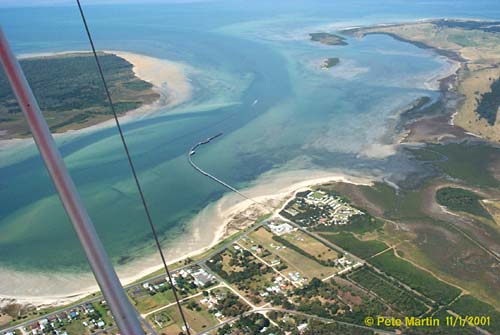
Port Welshpool, Gippsland, Victoria, Australia
http://www.walkabout.com.au/fairfax/locations/VICPortWelshpool.shtml Port Welshpool is located 191 km south-east of Melbourne via the South Gippsland Highway. Located at the north-eastern margin of Corner Inlet, it is not surprising that it initially relied almost exclusively on the ocean's marine life for its prosperity. An anchorage, apparently established offshore near Snake Island, was used by whalers as early as the 1830s.
 Port Welshpool from the air
Photo Copyright © (and by courtesy of) Ultralight pilot, Pete Martin
You also may download a 2x enlargement
The region was explored in the 1840s by the Gippsland Company, whose interest was stimulated by Count Paul Strzelecki's explorations of Gippsland and by the wreck of the Clonmel near the entrance of Port Albert. The area became part of a substantial land lease, stretching from the Albert to Agnes Rivers, taken out by John Gellion and partners, a Mr. Rickard and a Mr. Stratton. According to an early surveyor, the town was named after Patrick Welsh, who settled in the district and became a land-holder in the Alberton area. He had plans to make the port a major transportation centre for the produce of Gippsland. However, the journalist John Stanley James, claimed in 1886 that the name came from a village on the border of Wales and Shropshire. The town was gazetted as Welshpool in 1851, and was only officially renamed in 1952. Settlement and trading began almost immediately as the town was thought to have considerable potential. An 800-foot jetty was constructed in 1859 but burned down soon afterwards. Its replacement was used to facilitate the shipment of cattle and timber to New Zealand and Tasmania and to receive the fishermen's catches and imported supplies. The famous Australian novelist Hal Porter, who wrote portions of his autobiography, The Watcher on the Cast-Iron Balcony (1963), at nearby Hedley, recalled that cattle were steered in their hundreds across a long sand bar to Snake Island for pasturing. Chinese communities established themselves around the inlet as curers of fish and wandering Indian hawkers with their exotic wares became part of the local landscape. In 1889, a steam sawmill was built at Hedley by Mr Maison, who transported his railway sleepers, jetty piles and fish baskets to the port by bullock train, until a tramline was laid. Maison also received a badge of honour from the French government for the quality of the paving rocks he supplied for paving the streets of Paris. A hotel from a temporary township called Seaforth became the Port Welshpool Post Office in the late nineteenth century and it still serves that function today, although it has been considerably altered over the years. An early dwelling in Turnbull St, known as 'Crescent', dates from c.1873. In 1891, the arrival of the railway boosted the local fishing industry as it meant that the produce could be transported directly to Melbourne on a daily basis. The fish were carried to the station by horse and wagon until a tramline, which also ferried locals about for social occasions, was laid in 1904. Rail was eventually replaced by road transport in 1940. Today, Port Welshpool is a popular holiday and beach resort destination.
http://www.gippslandinfo.com.au/Wildlife/ The coastal route between Sale and Phillip Island is truly a unique part of our land. Located at the most southerly point on the Australian mainland, its combination of wild oceans, dunes, inter-tidal mudflats, mangroves, rainforest and coastal lake systems provides the visitor with possibly the most diverse nature-based touring experience in the country. It includes five national and coastal parks of major significance, including Wilsons Promontory and the Lakes National Park. In between there are numerous other reserves to provide a constant source of fascination and pleasure for the visitor, especially those interested in wildlife. Almost the entire route is on well maintained, sealed roads, although there are many opportunities to safely venture off the beaten track on a discovery all of your own. For most of the journey you will feel that it's just you and the elements, yet the comfort of a good bed and a hearty country meal is never too far away. If possible, take your time to wander this route, or promise yourself to return soon to discover all that it has to offer. For much of this journey you will be travelling alongside the splendour of the GippsIand Lakes system or the pristine expanse of the Ninety Mile Beach. Bird life is prolific throughout the coastal parks, while kangaroos, emus and echidnas are a common sight in some sections. ...more
http://www.sgsc.vic.gov.au/
Local ABC Radio : Gippsland
ABC News Online : Gippsland
|
© Copyright 2001-2002 CTIE - All Rights Reserved - Caution |